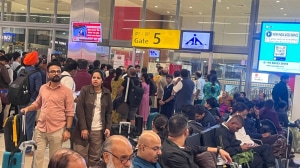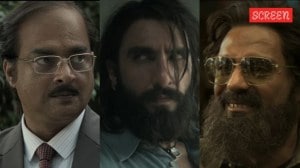And the judges said
Report on the debate set off by the recent rhetorical flourishes from the Supreme Court.
The imperialists formula of philanthropy plus five per cent is the accepted norm. Public-Private Partnership (PPP) is (its) latest mantra.
Justice Aftab Alam in Mahanadi Coalfields vs Mathias Oram and others,July 19,2010.
A greed-is-good culture promoted by neo-liberal ideologues,a miasmic cultural environment in which the state provides violent support to predatory capitalism and the wealthy are demigods.
Justice B Sudershan Reddy in Ram Jethmalani and others vs Union of India,July 4,2011.
Deep are the ditches created in our society by the so-called advance of globalisation.
Justice AK Ganguly in Harjinder Singh vs Punjab State Warehousing Corporation,January 18,2010.
The new mantra from the mandarins of security and high economic policy of the state tax breaks for the rich and guns for the youngsters amongst the poor so they fight among themselves.
Justice B Sudershan Reddy in Nandini Sundar and others vs State of Chhattisgarh,July 5,2011 (he retired on July 6).
The powerful,the elites and the governing classes continue to sing the same destructive tune of neoliberal paradigm.
Justice Reddy,days before the Chhattisgarh ruling,at the Vishakapatnam Bar Association.
JUSTICE REDDYS strong pronouncements against the elite,the rich and what he called the neoliberal paradigm have found more than an echo in a series of judgments and orders from the Supreme Court over the last year,setting off a debate whether these are ideological winds blowing from the bench and,if yes,on what message they carry.
It has divided experts with some calling this an impatient but innocent expression of judicial anguish,and others saying its merely grandstanding with little enduring effect. At least two former Chief Justices and several jurists,however,call for more judicial restraint and discipline,arguing that such comments not only detract from the supremacy of the court but also give ammunition to its critics who accuse the bench of overreach.
Ironically,the Supreme Court itself took note of this debate. It lashed out at these critics,accusing them of being pro-rich,when on July 12 Justice G S Singhvi and Justice A K Ganguly,in a judgment on conditions of employment for manual scavengers,slammed some lawyers,journalists and men in public life for taking an elitist and status quoist approach.
Justice Singhvi said the court is praised when it favours the sugar barons and alcohol kings and condemned with a theoretical debate raising the bogey of judicial activism when it gives relief to the poor in a genuine public interest litigation.
Facts,however,belie this. For,the court has a formidable record of pushing for the rights of the poor and the marginalised in a range of areas,from relief and rehabilitation in major projects to human rights. Critics refer to a judgment by Justice Dalveer Bhandari (State of Uttaranchal vs Balwant Singh Chaufal,January 18,2010) to point out that the court has a history of hearing the little Indian.
Little Indians in large numbers seeking remedies in courts through collective proceedings,instead of being driven to an expensive plurality of litigations,is an affirmation of participative justice in our democracy, Justice Bhandari said. On the same point,again,in the Reliance gas row,Justice P Sathasivams majority judgment upheld the constitutional mandate that the natural resources belong to the people of this country.
A judgment on July 6,2011,by a green bench headed by Chief Justice of India S H Kapadia allowing cement major Lafarge to mine the Khasi Hills of Meghalaya is a study in contrast to Justice Aftab Alams observation that rehabilitation around large-scale mining projects follows an imperialist formula. The bench,of which Justice Alam is a member,found it was the indigenous tribes themselves who had leased out the land to Lafarge for limestone mining because they did not have the means to exploit the resource. We are fully satisfied, the bench said,that the natives and the indigenous people of Nongtrai Village are fully conscious of their rights and obligations towards clean environment and economic development.
Then,the three-judge bench led by Chief Justice Kapadia ordered the immediate ban of pesticide endosulfan on May 13,2011,disregarding pleas of over 150 private export companies,saying that any decision affecting human life,or which may put an individuals life at risk,must call for the most anxious scrutiny.
Therefore,critics doubt if observations about the amoral political economy the state endorses and the double exclamations The horror! The horror! attributed to predatory capitalism and neoliberalism are necessary to judgments and orders.
THE TEXT & CONTEXT
There is a historical context to the current outburst,says A Lakshminath,an expert on Constitutional law and Vice Chancellor of Chanakya National Law University,Patna. The judiciary before the 80s was restraintive. They were not responding to popular sentiments. Then came these judges who discovered the public interest litigation to introduce radical judicial reforms. People who could never reach the Supreme Court began to seek justice there. This activism was founded,again,when the other organs of the state were ailing.
But the current rhetoric on the rich-poor divide,he says,is avoidable. The simple fact is that when we make laws for the rich,it applies to the poor too. A certain judicial restraint is necessary even if the sentiment is overpowering. People react to these observations,probably not knowing that obiter dicta is not binding, Lakshminath said. The judges want to show their anxiety,their response to the situation in the country… they feel they have a role to play and cannot sit aloof.
Such rhetorical flourishes also fly in the face of what Chief Justice S H Kapadia so clearly outlined in his Setalvad Memorial Lecture last April: A judges obligation must start and end with his analysis of law,not with personal beliefs or preferences.
After all,some argue,Justice H S Bedis bench released Binayak Sen,sentenced to life imprisonment for sedition,on bail in an equally potent but cautious order on April 15,2011,refusing to give any reasons lest we should prejudice any party. The entire order was just one paragraph.
Former Chief Justice of India J S Verma underlines this. Once in a while,everyone crosses the limit,but the basic rule is that a judgment should not contain anything not necessary for the judgment not one sentence more than necessary. It should not contain anything that has not been addressed by either the counsel or the parties. Of course,these can be perceived as casual observations which are not binding,but obiter dicta should be avoided as far as possible. They can unnecessarily impact other cases in which the observations become relevant.
But jurist Fali S Nariman sees no such danger in the current context. I am all for it. If the executive has failed in its constitutional duty,the judiciary will observe it has so in its judgments. Please do not go by those who say there is judicial overreach. There is so much corruption in the government, he says.
Nariman echoes a cross-section of popular opinion that a government pushed to the wall in one corruption case after another cannot take the moral high-ground and lecture the judiciary on exercising restraint.
Disagrees senior advocate P P Rao. He cites a 1952 judgment by former CJI Patanjali Sastri that observations made in a judicial decision should be dictated by a sense of responsibility and self-restraint. Rao says the two orders of Justice Reddy in the Ram Jethmalani and Nandini Sundar cases have failed this touchstone: These two judgments rendered by one and the same judge have assumed critical notice from jurists and journalists of eminence on the very same day. That is an indication that these observations could have been avoided.
Institution & individual
Former Chief Justice of India V N Khare says there is no room for personal ideology in judgments and orders. Judgments are institutional decisions,not individual decisions. We can give directions when a law is found repugnant or when an amendment is contrary to the basic features of the Constitution. Judgments reflect the institution,we cannot allow personal ideology to creep in, he says.
A Jayagovind,who teaches international trade law at National Law School of India University in Bangalore,says judges lack the political mandate to say this is good or that is bad. Let us only consider the judge as an intelligent,hardworking person. He is definitely not the wisest person around. Ideological statements in judgments make the judge controversial. Ideology is amorphous.
His colleague and Vice Chancellor R Venkata Rao suggests that the current outbursts involve a select number of judges not the Supreme Court as an institution. If the judges are now criticised for being anti-liberalisation,says Rao,they have also been called pro-liberalisation in the past for their ideological statements.
Activism was seen largely in the late 70s. Justice Krishna Iyer,Justice Bhagwati also gave ideological statements in their judgments. This trend continued for roughly 10 years,then there was a lull after 1993 when the so-called liberalisation began. Judgments like in the BALCO divestiture case were clearly supportive of liberalisation. But critics then pointed to the word socialist in the Preamble of the Constitution and asked how the Supreme Court could ignore this and give judgments in support of liberalisation, says Rao.
Rao says these ideological lectures should not be taken so seriously. Who is bothered by these lectures? These are not res judicata. The common man is only bothered about the delivery system and not ideological predilections and classroom lectures of judges. Today,the common man has tremendous confidence in the Supreme Court, he says.
Judges,he says,have a tendency to pontificate. In the Kesavananda Bharati case each judge pontificated. There is no point using terms like neoliberalism,there is no point being hyperactive. It is not judicial activism like forming a commission on black money we want,it is judicious activism we want.
- 01
- 02
- 03
- 04
- 05































